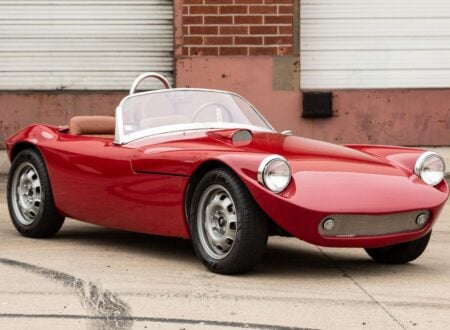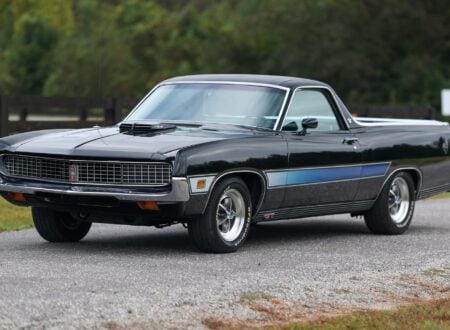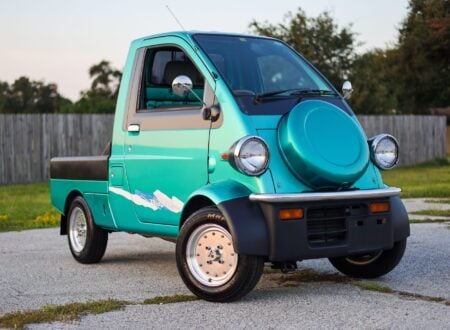This 1974 Ford Transit Van may be immediately familiar to you if you’re a fan of the television program Wheeler Dealers, as it featured prominently in Season 17, Episode 13 of the show.
The van was acquired by Mike Brewer then rebuilt by Elvis as part of the series, and converted to righthand drive. It was then sold to a customer, but later borrowed back by Brewer for a show, then bought back by him for his own private collection.
Fast Facts – The Wheeler Dealers 1974 Transit Van
- When the Ford Transit Mark I entered production for the first time in late 1965. It was initially manufactured at the same factory in Berkshire, England that had been producing the Hawker Hurricane fighter plane during WWII.
- This first-generation Transit (mechanically unrelated to the earlier Taunus Transit) would remain in production from 1965 until 1977, a 12 year run that remains the longest of any Transit to date. There were a number of minor updates over the production run, including a facelift in 1971.
- The Transit was developed to replace the earlier Ford Thames 400E van. It would certainly succeed in improving over the 400E in every way, and the Transit would go on to sell over 8 million units across a four generations (and counting).
- The Ford Transit you see in this article is a 1974 model which was bought by Mike Brewer and featured in the TV show Wheeler Dealers. It was later sold and then bought back to become part of the Brewer Collection. It’s now being offered for sale to help fund a new (and expensive) project.
The Ford Transit
The Ford Transit debuted in 1965 it had been developed as a blank slate replacement for the earlier, and smaller, Ford Thames 400E van. The Transit was both larger and more powerful, with a distinctive pug-nosed front end. Its unusual looks so endeared it to a generation of tradesmen, and it would become one of the best selling vans ever made – with over 8 million sold so far over four generations.
Above Video: This is a clip from the original Wheeler Dealers episode about this Transit, and it shows all the work that was done to bring it up to its current condition.
When production of the Transit first began in October of 1965 it was being built at the Langley factory facility in Berkshire, a town in southern England about an hour east of London. This was the same facility that had been producing the wildly-successful Hawker Hurricane fighter plane during WWII.
It seems some of the Hurricane’s spirit lived on in the Transit – it was soon selling in numbers far higher than the facility could manage and production was moved to Southampton.
Over the course of the 1965 to 1977 production run the Mark I Transit was offered with a number of engine options, including the popular Ford Taunus V4, the Essex V6, an Australian Ford Falcon 3.3 liter straight-six, and two diesel inline-fours.
By far the most common variant was the Taunus V4-powered model, which offered surprisingly good performance (when the rear was empty) thanks to its wide track and car-like handling. Some even claimed the Transit could outperform popular sports cars of the day like the MGB, though not the V8 version of course.
The performance of the Transit wasn’t lost on the British criminal community, who soon put it to work in a spate of bank robberies, essentially replacing the earlier Jaguar Mk2 “Gentleman’s Express” as their preferred getaway car.
“Ford Transits are used in 95 per cent of bank raids. With the performance of a car, and space for 1.75 tonnes of loot, the Transit is proving to be the perfect getaway vehicle” – Scotland Yard, 1972.


Ford of Europe would release the first generation Transit in a variety of body variants, these included long and short wheelbase versions, panel vans, pick-up truck, passenger minibuses, and crew-cabs. Many caravan and camper van companies also turned their hands to producing camper van versions of the Transit, many of which are still in regular use today.
The Mark I Transit was replaced with the Mark II in mid-1977. It shared a clear stylistic link with its forebear but was considerably modernized, though it never quite became the same cultural icon as the first model.
The Ex-Wheeler Dealers Transit Van Shown Here
As explained in the introduction, this van was featured in episode 13 of season 17 of Wheeler Dealers. It received a full restoration and a conversion to right hand drive, this conversion being a far bigger job on the Transit than it is for most other vehicles, requiring the entire engine, gearbox, and many other parts to be removed.
The van was sent off for a respray in Ford Light Grey paint, which was its original color. This van had apparently been used as a German Fire Service truck when new, which helps explain the low-mileage of just 10,000 miles – far lower than the odometer readings on the Transits that were used for delivery services.
Once the restoration was completed the van needed to be sold to see if they could recoup the original price and earn some profit. As a result the Transit was sold to a local van dealer, Mike then borrowed it back a while later to take it to the Classic Motor Show at the NEC with some other vehicles to put it on display.


It was over this period that Mike fell in love with the van, and bought it back from the dealer to add to the Brewer Collection where it has remained for a number of years. Mike now has a new acquisition on his radar and as a result he’s selling off a handful of vehicles from the collection somewhat reticently, including this Transit and two Porsches.
The van is now due to roll across the auction block with Iconic Auctioneers on the 18th of May at the Sywell Aerodrome in England. If you’d like to read more about it or register to bid you can visit the listing here.




Images courtesy of Iconic Auctioneers








